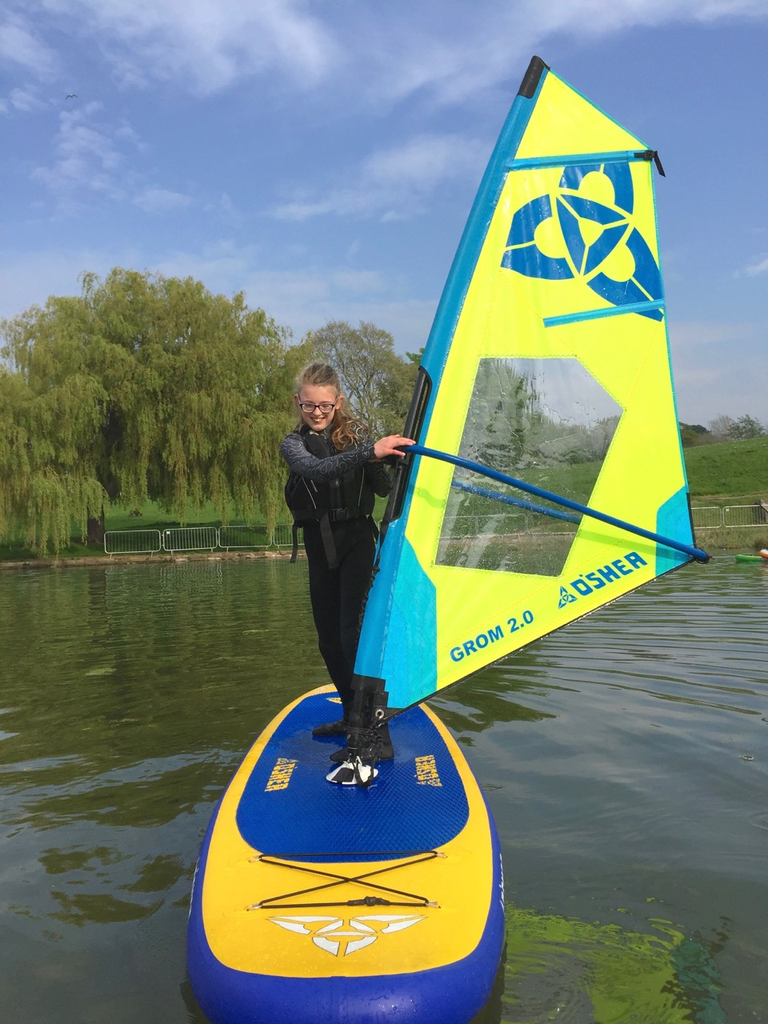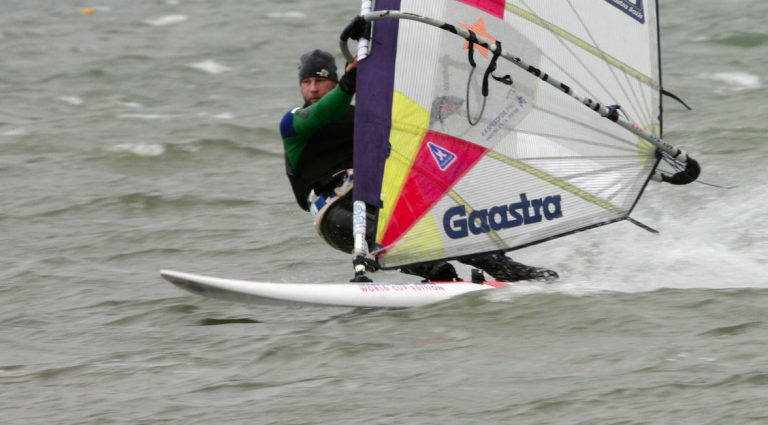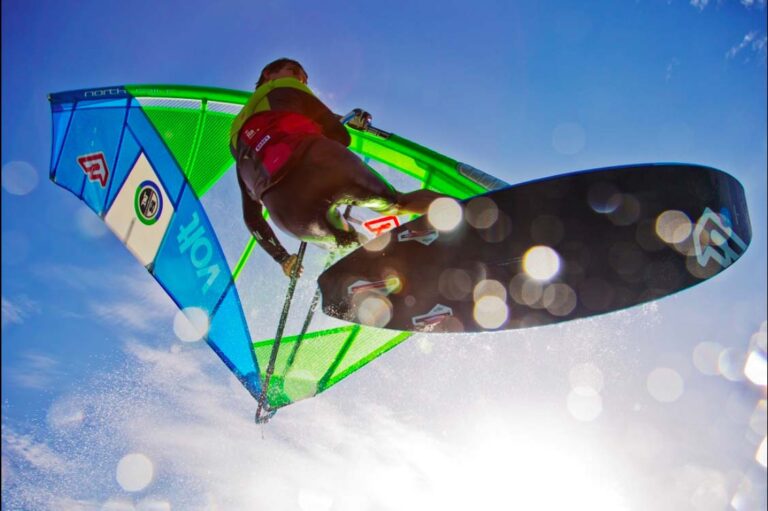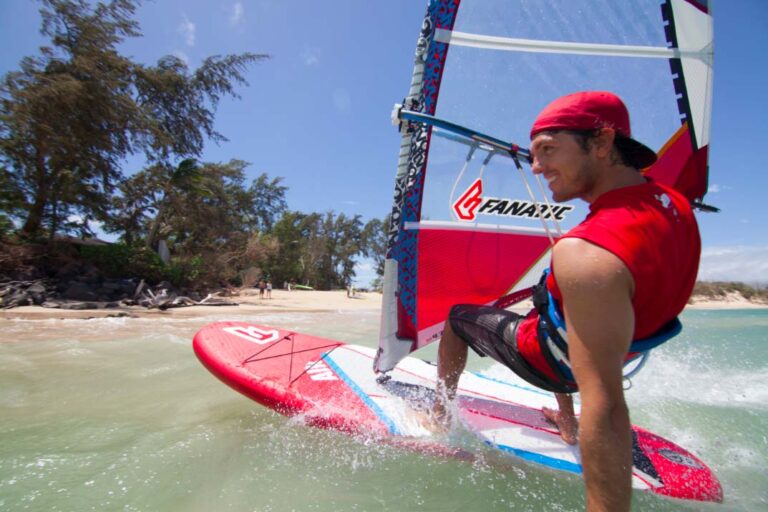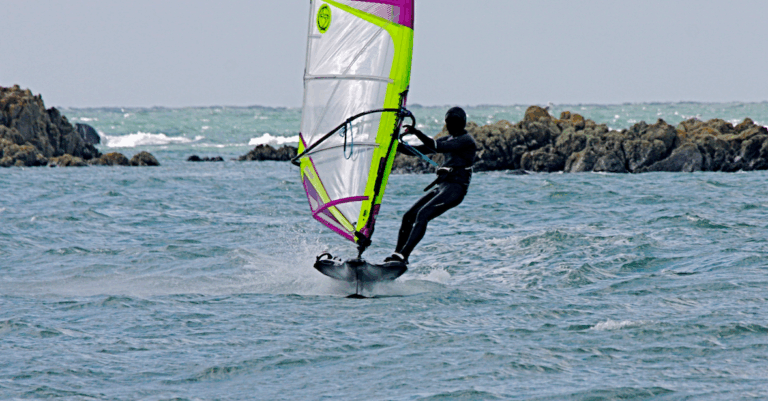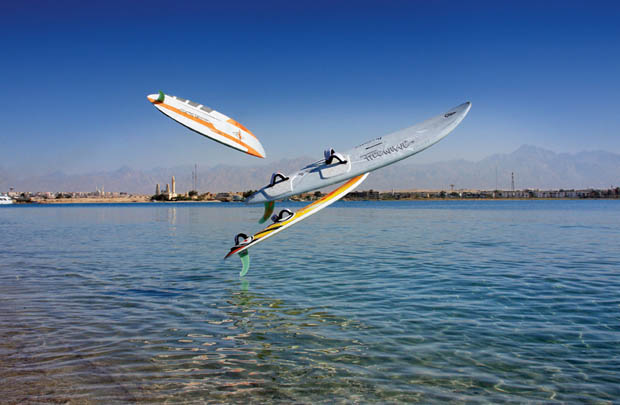
The Test Team conduct their first examination of the new breed of small (under 80L) freestyle-waves, and compare them to waveboards and fast twinsers in similar size…
Although we’ve often included the occasional small freestyle-wave (FSW) in waveboard tests, this is the first time we have collected together a significant number in one line-up. Quite a few brands see the 85L (57-58cm width) model as the smallest viable size, but this has always seemed very unfair on a large section of the buying public who have loads to gain from smaller freestyle-waves. Indeed, when you consider how many sub 70kg sailors there are out there it always seems odd that there aren’t a lot more 70, 75 and 80L freestyle-waves being made and sold. Obviously their main market is as a versatile all-rounder for lighter sailors, like our guest tester Helen, of which more later. However, these 76-80L versions even proved to be excellent high wind all-round boards for our medium weight 72-79kg testers, brilliant for jumping, great for blasting and gybing and OK for both a bit of onshore riding and high wind freestyle as well.
Freestyle-Wave or Waveboard?
One of the questions we were looking at with this test was where the one takes over from the other, as the board of choice for ‘Euro style’ onshore coastal sailing. To this end we took the next size up of the two twinsers with the fastest, earliest planing rockerlines from our wave test earlier in the season. We certainly don’t want anyone to assume from this that a waveboard has to have two fins to be any use these days, but it did seem like a good opportunity to try out a couple of boards that people are keen to know about. To complement these boards we also included the Exocet X-Wave, a board that we know to have a very fast rockerline that is similar to those featured on the freestyle-waves, and the Fanatic New Wave, a conventional waveboard.
Of course, there is no simple answer to the ‘freestyle-wave or waveboard?’ question. The market is currently mad about waveboards and there are a huge number of varying designs aimed ultimately at a small minority of buyers. The twinsers, as this test yet again proved, are very much at the waveriding end of the waveboard spectrum. Depending on the exact design they can be quite OK for jumping but they would never be first choice. Similarly, even this relatively fast rockered pair are far from being ideal high wind boards for ordinary sailors. Waveriding in scrappy onshore conditions requires considerable skill and practice. Many ‘waveboard’ buyers don’t actually want a board that is primarily aimed at riding, let alone a twinser. For them a freestyle-wave or more conventional waveboard is almost certainly the better bet.
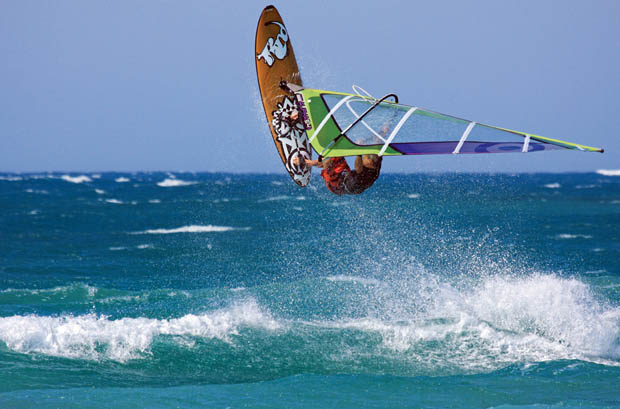
However, there is no doubt that the new riding boards, whether with one or two fins, do give a new and inspiring impetus to those who like to go frontside, and the Mistral and RRD certainly both proved very popular with our skilled testers and guesters.
WHICH IS BEST?
We have received some stick on the website forum for not always coming off the fence about which boards are our favourites. It’s a tricky one. We have no problems with shouting about it when we genuinely believe certain products to be clearly more popular or more suited to their core usage. However, it would be unfair and misleading to pretend that boards we may only slightly prefer should be praised way above the others. Sometimes we find every single board appealing, albeit for slightly different uses or reasons. And this test is very definitely one of those: Every board here could potentially find someone who genuinely preferred it to all the others. There are actually no boards here that I wouldn’t enjoy using and be happy to have in the shed.
Wave vs Freestyle-Wave
There is a clear distinction between a ‘classic’ freestyle-wave shape and most ‘waveboards’. However, the distinctions do of course get blurred around the edges as brands legitimately try to get the best of both worlds with hybrid designs. Here we will detail what we believe the major differences are in design and use.
Rocker: Rocker is the key. We take two measurements that impact on the crucial tail half of the board: ‘Tail rocker’ and ‘2cm point’. If you turn the board upside down and put a straight edge longitudinally along the centreline you can easily see how much tail rocker there is at the very tail. Looking forward, you can also see how long or short the ‘planing flat’ is. It may not technically be flat as there is always a slight curve going forward but we measure the planing flat as up to the point where the rocker has pulled away by 2cm from the straight edge. The figures you get are rough but very useful guides to the type of performance you can expect.
Tail rocker: Waveboards typically exhibit tail rocker of between about 7-15mm while freestyle-waves have c. 0-8mm. Tail rocker will always cause drag which is a ‘bad thing’ in marginal planing conditions, but a ‘good thing’ in high powered conditions as it aids control and turning.
2cm point: 2cm point measurements tend to vary between about 130 and 145cm in waveboards and about 140 and 155cm in freestyle-waves. A short ‘planing flat’ (i.e. a rearward 2cm point) means the board will tend to sit nose down in the water and therefore need pumping skill to sit on its tail-flat and release. (The figure isn’t a totally clear-cut guide to early planing performance though, as other design features such as tail width and tail rocker also have a very big influence on this aspect of performance.)
Once planing, the board with a low 2cm point number will have less planing area in contact with the water, and therefore usually feel more ready to manoeuvre and easier to lift into jumps or take-offs. It will also give a more upright ride and take more skill (or wind) to take upwind. Boards with longer planing flats tend to be much easier to blast around on, stay flatter over chop, keep speed better through lulls and coming out of gybes, etc, and stay upwind more easily.
Typical profiles
A typical 80L freestyle-wave might have 5mm tail rocker and 150cm planing flat. A typical 80L waveboard might have 10mm tail and 140cm flat.
Comparative performance: If the above typical boards were otherwise identical you would expect the freestyle-wave to work quite efficiently with a light to normally powered 5.7m sail, whereas the waveboard would be sucking back off the plane. In gusty 5.3 conditions you might intermittently feel the same effect. With smaller sail sizes it would not be an issue.
In flat water (nicely powered) you would expect the freestyle-wave to ride flat and it would track securely and be very easy to keep speed. It might feel quite ‘fast’ in short chop but should stay settled. The waveboard will need more concentration to drive and take more effort to develop speed. In very flat water it should feel lively and fun but as chop increases it will get more lifty and bouncy and be less fun to sail. Generally waveboard rockers are not great in chop but love the flat water that waves create.
The freestyle-wave makes a great jumping board because it is relatively easier to get composed and accelerate quickly in the space between waves, and often easier to stay flat and tracking over white water. This is very noticeable in marginal conditions or, as so often, when it is a bit iffy on the inside.
When waveriding with medium power the advantage of the waveboard is often overstated. The freestyle-wave has the advantage of keeping speed better and being less likely to stall, while the waveboard is slightly easier to turn. Actually it is usually not until you get very well powered in the ride when the flatter rocker of the freestyle-wave starts to actively feel stiff that the waveboard takes over as clearly the better rider.
Other Design Factors
Vee: It is very common, but by no means universal for waveboards to have low vee or single concave since it makes them a bit more pivotal and redirectable. Freestyle-waves tend to have more vee since it gives them more tracking grip, making them easier to control, take upwind, kick into take-offs and hold onto the water in a blow.
Width / Planshape: There was a time when freestyle-waves had greater width to volume ratios than waveboards, particularly in tail and nose, but this is no longer the case with the arrival of onshore riding boards.
Length: Lengths similarly are no longer a distinguishing factor.
FREESTYLE-WAVES
This category obviously features the JP and RRD FSWs, and also the Tabou 3S and Fanatic Freewave. However, we can also include the Exocet X-Wave, which has a freestyle-wave rockerline and in use is actually much more similar to them than any of the waveboards.
There isn’t a lot to choose between the Fanatic Freewave and RRD FSW in terms of style and quality. Both are very versatile classic fast-tail boards with excellent range. The RRD feels a bit more comfy underfoot and seemed to have the edge for manoeuvrability and waveriding, while the Fanatic feels a little bit sharper and more exciting. The Exocet X-Wave is very similar again but feels a tiny bit bigger, perhaps suiting a slightly heavier rider. It too feels sharp and dynamic and is quick and excellent for jumping but no more manoeuvrable than the other two.
The JP FSW feels slightly smaller and needs a slightly stronger or more consistent wind for optimum use, but feels extremely fast and agile, with more of a jumping and flat water bias than the other FSWs.
The Tabou 3S is clearly bigger, and also feels slightly different to the others, a bit calmer and more composed and slightly more pivotal and manoeuvrable with its shorter planing flat. It is one of the better riding boards with good flow and easy turning and the extra width and wide low nose gives it very good freestyle suitability as well.
Team Choices: Helen preferred the Fanatic for the secure way it gripped and gybed whilst feeling fast and responsive. She had the RRD in second place. Chog’s vote went to the JP, based on its exciting feel and jumping performance. Paul preferred the X-Wave based on its great jumping and gybing and also on the way it held speed when riding, but he also gave special mention to the Fanatic. Emile seemed very happy with the Tabou, RRD and Fanatic and didn’t choose a favourite. Personally I would pick the RRD over the Fanatic based on its slightly higher nose rocker and more comfy deck (relatively small details), but have a strong soft spot for the less aggressive feel of the Tabou.
THE WAVEBOARDS
This leaves us with just the two twinsers and the Fanatic New Wave. These were three quite different boards. The Fanatic New Wave felt a bit smaller, more rockered and needed a little more wind. However, it was a credit to it that it still managed to compete for jumping and gybing with the freestyle-waves with a 5.4m sail – it is far from being a just a specialist ‘high wind – big wave’ board! When the wind came up and we were down to 4.7 and 4.5m sails it really was the board of choice for jumping and staying nicely in control in the break. Despite the single concave it never seemed to give any control problems, proving very secure and reliable. For riding it felt incredibly sharp and quick and easy to turn at speed. However, in very onshore conditions it loses speed a bit quicker than the other waveboards and doesn’t have the same nose width to help it in the top turn.
The two twinsers were extremely different to each other. The Mistral has a very wide tail, a very short planing flat and lots of tail vee while the RRD has a narrow tail, a long planing flat and very little tail vee. The RRD feels the more conventional and the easier to sail around the break but it was a bit more skatey on its fins and sensitive to back foot pressure. It felt easier to play around on in the waves without the need for full commitment or full power and it was very loose and easy to redirect. The Mistral seemed to need a bit more power and commitment to work but really does engage a rail and grip and go fast and tight into its turns. The potential for getting ‘hero rides’ is pretty high. It is not the easiest board to just sail as it is very short and very wide, but you get used to it and it jumps quite well. Both seemed to offer a lot of potential in the onshore riding conditions we had, particularly for the very skilful sailors, but the experience they gave could hardly have been more different.
Team Choices: Helen preferred the New Wave since it offered the most control and was fast and responsive. The RRD came in second, which she found a bit big but fun when not overpowered. Chog was totally sold on the RRD and considering a purchase. It was the riding he fell in love with, finding it gave him “total confidence in the bigger smacks and ridiculously quick carves in the smaller stuff”. Paul at 89kg appreciated the wider tail and max width of the Mistral. He found it much easier to push against the fins for jumping and that it was very loose when riding. He too is considering a purchase!
Emile too was totally sold on the Mistral, commenting: “Bottom turns seemed to get me that bit further round and so were more vertical, and I could really snap it easily on top turns. It just put a smile on my face.” Yet another potential purchase?
Not being quite as good as Emile at onshore riding (or much else actually) I enjoyed the twinsers, but would have needed a kinder onshore angle to really get into their riding potential. I thus didn’t really have a preference but would really, really like to use all of them in appropriate conditions. Mistral – medium waves any wind angle, so long as it’s not within 35 degrees of onshore. RRD – small waves any wind angle. Fanatic – any time when I’ve got plenty of power on the wave either through loads of wind or a well formed cross-shore wave; or simply for well powered jumping.
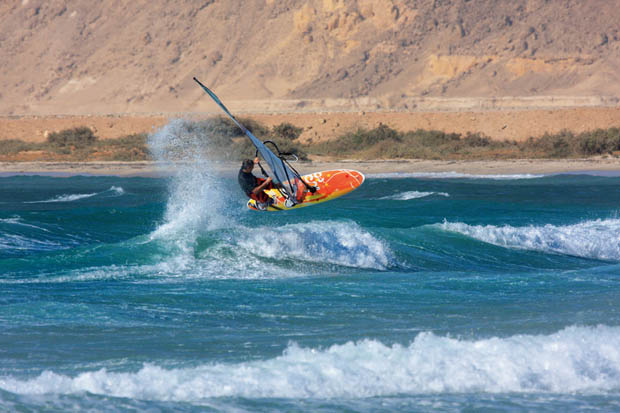
Board Size
The basic rule for freestyle-waves, as for most boards is to match the width and volume to the largest size of sail you will be using with it. For a 77L / 56cm freestyle-wave the largest sail we’d recommend would be a 5.5m. If you’ve already got a 5.7 or 5.8m that’ll be fine too but by going bigger than about 5.5m you won’t derive much benefit from the extra area so you are unnecessarily increasing drag and weight.
| Rough guide matching sizes of freestyle-wave to max comfortable and efficient sail size | |||||
| 55cm | 56cm | 57-58cm | 59cm | 60-61cm | 62-63cm |
| 75L | 80L | 85L | 90L | 95L | 100L |
| 5.3m | 5.5m | 5.8m | 6.0-6.2m | 6.3-6.5m | 6.7-7.0m |
Size to Bodyweight
It is also useful to match appropriate board size to bodyweight. We have found that a rough equation of freestyle-waves being 10L above the sailor’s weight in kg works well for most competent sailors.
|
Rough guide – FSW board to bodyweight for competent sailors |
|
||||
|
55cm |
56cm |
57-58cm |
59cm |
60-61cm |
62-63cm |
|
75L |
80L |
85L |
90L |
95L |
100L |
|
65kg |
70kg |
75kg |
80kg+ |
85-90kg |
90-100kg |
This table assumes that sailors are quite at home with boards that will not easily float them in light winds and that they are not expecting to use the board when not planing or for moderate wind freestyle.
Adjustments
Ability: Go up between one or three sizes depending on how new you are to ‘small’ boards and how confident you are with low volume boards.
Moderate wind suitability: If you want to be able to confidently sail when not planing you will need to go up at least a couple of sizes.
Freestyle: Going up a size or two will help freestyle performance in moderate to medium winds, but many people like a fairly small freestyle-wave for stronger wind freestyle.
Strong wind / specialist jumping use: If you want a medium to stronger wind board for jumping and control in a variety of water states (rather than a waveboard) you should consider going down a size.
THE TEST
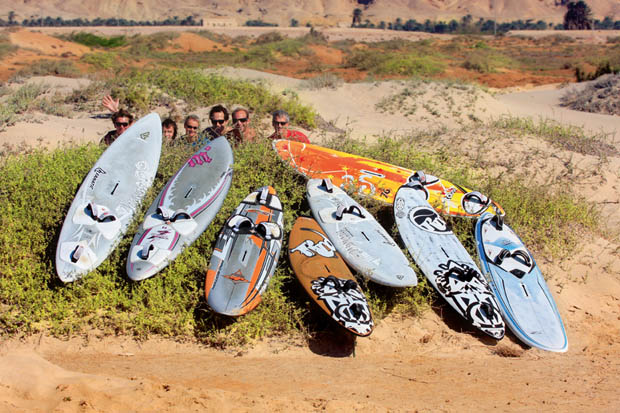
The test was carried out at the OceanSource centre in El Tur Egypt, where the varied sailing conditions are perfect for testing boards of this nature. We did most of the testing at Habibi Beach which offers waves that get above head height and medium to strong cross onshore winds. However, we also tested the boards in the flat water of the harbour and the rolling swell and chop outside the harbour.
We’d like to thank OceanSource and the Moses Bay hotel as well as the importers who helped us with equipment with which to test the boards. Thanks go to: Tushingham for the loan of their reliable and comfortable Aeron booms, 5.2m Storms and 4.7m Rocks which saw loads of action.
Neil Pryde for their powerful 5.4 Alphas that were the perfect biggest size for the freestyle-waves.
Gaastra for a very nice pair of 5.0m Manics.
North for providing a pair of 4.5m sails much appreciated by our lightweight sailors when the going got tough.
The Testers
The magazine team consists of test Editor Ian Leonard and tester Emile Kott and has recently been buoyed up by the inclusion of new staff writer Paul Griffiths. At 89kg Paul carries the batten for the heavier sailor while Emile and Ian both clock in at under 80kg.
We were particularly lucky to have three highly able guest testers on this trip with a good spread of weights. Our lightweight, Helen Trehane is introduced elsewhere. Chog Burley is an unusually expert weekend sailor aided by extended trips to windsurfing paradises when ‘between jobs’ and on honeymoon. He weighed in at 72kg. Finally Sam Ross is a well known and able senior instructor with Nielson in Dahab. He weighs in at 86kg and consequently didn’t have a great deal of input into this particular test. We will introduce all three of them in more depth next issue.
Pix were by our favourite Polish snapper Andy Joswik who was also busy getting in our faces with his posh video camera. If all goes to plan there may be some testing footage on the website soon!
|
|
Width |
|
|
Rocker |
|
|
|
|
Other |
|
|
|
|
|
|
Tail |
Nose |
Max |
Planing |
Tail |
2cm |
30cm |
Overall |
Weight* |
Vee |
Length |
Volume |
Fin (cm) |
|
Fanatic Freewave 77 |
34.8 |
34.4 |
56 |
53.3 |
6 |
155 |
10.6 |
22 |
6.3kg |
08/10/2008 |
234 |
77L |
23 (P) |
|
JP Freestyle Wave 77 |
34.5 |
34.8 |
56 |
53.5 |
10 |
150 |
12 |
24.3 |
5.7 |
4/4ch/2 |
234 |
77 |
23 (P) |
|
RRD Freestyle Wave 80 |
35.7 |
37 |
56 |
53 |
4 |
149 |
13.2 |
26.2 |
6.5 |
5/8/9dc |
228 |
80 |
22 (C) |
|
Tabou 3S 76 |
36.7 |
41 |
57.5 |
54.8 |
1 |
147 |
10.2 |
21.2 |
7.2 |
10/8dc/7 |
228 |
76 |
23 (C) |
|
Exocet X-Wave 83 |
36.2 |
37.5 |
56.2 |
53.5 |
5 |
154 |
12.8 |
25.5 |
6.6 |
8/6dc/10dc |
235 |
83 |
21 (C) |
|
Fanatic New Wave 81 |
34.1 |
34.9 |
56.5 |
53.5 |
12 |
140 |
12.5 |
24.5 |
6 |
3sc/3scdc/1sc |
238 |
81 |
23.5 (C) |
|
Mistral Twinzer 84 |
36 |
38.7 |
59.7 |
57.3 |
9 |
137 |
11 |
21.2 |
6.5 |
13/7dc/2 |
223 |
84 |
2 x 16.5 (C) |
|
RRD Wave Twin 82 |
32.9 |
41 |
57.5 |
54.7 |
10 |
146 |
11 |
23.2 |
6.5 |
1dc/6dc/5dc |
231 |
82 |
2 x 16 (C) |

